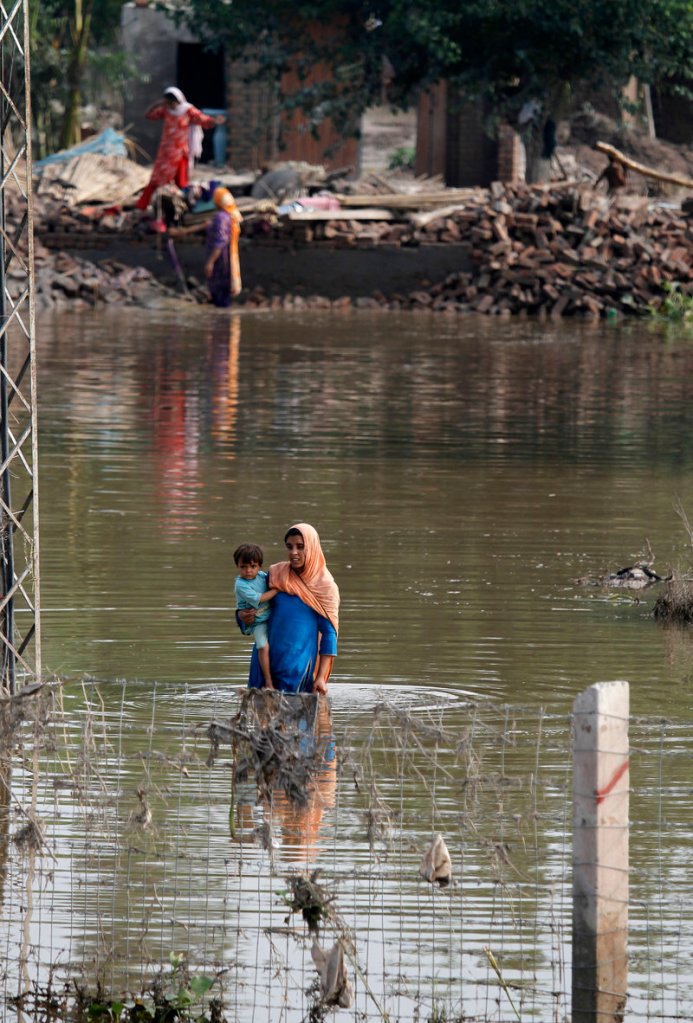KARACHI, Pakistan – Pakistan’s deadliest floods in decades have killed more than 1,500 people and overwhelmed government efforts to provide aid, officials and relief workers said Monday.
With President Asif Ali Zardari touring Europe, the government said it was rushing help to the devastated northwestern province of Khyber Pakhtunkhwa, where the army has fought Taliban guerrillas. Islamic militant groups in the region and the United States both have built public support in the past by providing assistance to bolster government attempts.
Monsoon rains will continue for the next few days after ripping out bridges, roads and villages since late last week, said Nasir Khan, a Meteorological Department official in the provincial capital, Peshawar.
Regions downstream in the Indus River valley, where most of Pakistan’s 162 million people live, braced for floods that may damage crops, according to the nation’s biggest agriculture body.
More than 1,500 people have died in Khyber Pakhtunkhwa, said Noor Muhammad, a press officer for the provincial development ministry.
Pakistan dispatched medical teams Monday to the deluged northwest amid fears that cholera could spread after the worst floods in the country’s history, an official said.
The disaster has forced 2 million people to flee their homes. Residents have railed against the government for failing to provide enough emergency assistance nearly a week after extremely heavy monsoon rains triggered raging floodwaters in Khyber-Pakhtoonkhwa.
The government says it has deployed thousands of rescue workers who have so far saved an estimated 28,000 people and distributed basic food items. The army has also sent some 30,000 troops and dozens of helicopters, but the scale of the disaster is so vast that many residents said it seems like officials are doing nothing. Thousands more people in the province remain trapped by the floodwaters.
The flood victims’ anger poses a danger to the already struggling government, now competing with Islamist movements to deliver aid in a region with strong Taliban influence.
“We need tents. Just look around,” said flood victim Faisal Islam, sitting on the only dry ground he could find in Nowshera district — a highway median — surrounded by hundreds of people in makeshift shelters made of dirty sheets and plastic tarps.
Like many other residents of Pakistan’s northwest, people camped by the highway in Kamp Koroona village waded through the water to their damaged houses to salvage their remaining possessions: usually just a few mud-covered plates and chairs.
“This is the only shirt I have. Everything else is buried,” said Islam.
The army has given them some cooking oil and sugar, but Islam complained that they need much more.
Government and private relief agencies are managing to provide “only 5 percent of what’s required,” Mujahid Khan, provincial spokesman for the Edhi Foundation, which runs Pakistan’s largest ambulance and rescue services, said by phone from Peshawar.
People in the northwest also face the threat of waterborne disease — which could kill thousands more if health workers cannot deliver enough clean drinking water and treat and isolate any patients in crowded relief camps.
Officials have yet to receive concrete reports of cholera cases, but fear of an outbreak is high, said Sohail Altaf, the top medical official in Khyber-Pakhtoonkhwa.
— The Associated Press and Bloomberg News contributed to this report.
Send questions/comments to the editors.



Success. Please wait for the page to reload. If the page does not reload within 5 seconds, please refresh the page.
Enter your email and password to access comments.
Hi, to comment on stories you must . This profile is in addition to your subscription and website login.
Already have a commenting profile? .
Invalid username/password.
Please check your email to confirm and complete your registration.
Only subscribers are eligible to post comments. Please subscribe or login first for digital access. Here’s why.
Use the form below to reset your password. When you've submitted your account email, we will send an email with a reset code.